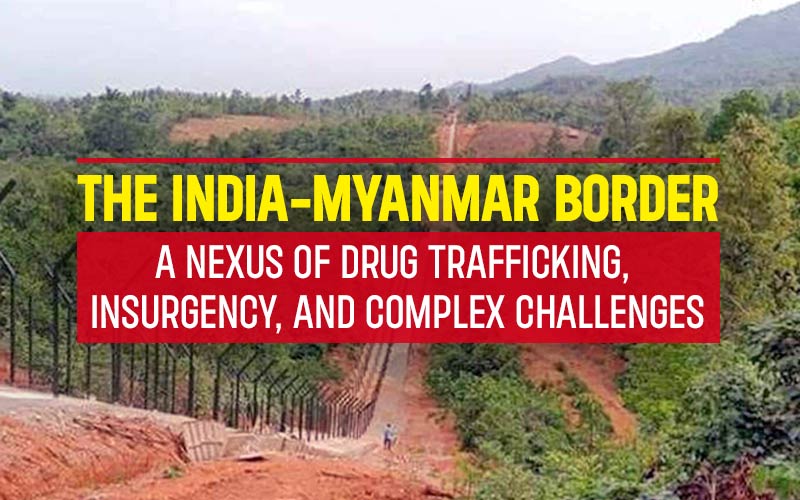
The India-Myanmar Border: A Nexus of Drug Trafficking, Insurgency, and Complex Challenges
The India-Myanmar border, stretching
1,643 kilometers through rugged terrains and dense forests, is a crucial
frontier for India’s strategic and economic ambitions. However, it is also a
hotspot for drug trafficking and insurgency, two interconnected challenges that
complicate the region's stability and security.
Drug Trafficking: A Growing Menace
The Golden Triangle, a notorious region
encompassing Myanmar, Laos, and Thailand, is one of the world's largest
producers of opium and synthetic drugs like methamphetamine (yaba tablets).
Myanmar's Shan state, in particular, is a significant source of these
narcotics, which find their way into India through the porous border.
Routes and Mechanisms:
Drugs are smuggled via hidden trails and
rivers across the border states of Manipur, Mizoram, and Nagaland. Transit hubs
like Moreh in Manipur and Champhai in Mizoram are critical nodes for drug
distribution, often disguised as trade goods.
The easy availability of drugs has led to
a sharp rise in addiction rates, especially among youth in border states. Drug
money fuels insurgent groups, creating a vicious cycle of dependency between
traffickers and militants.
Insurgency and the Border
The India-Myanmar border has long been a
haven for insurgent groups seeking refuge from Indian security forces. Many of
these groups use Myanmar's ungoverned spaces to establish camps, procure
weapons, and plan attacks.
Insurgent groups often engage in drug
trafficking to fund their operations. The illicit drug trade provides a
lucrative source of income for purchasing arms and sustaining their cadres.
This collaboration extends beyond smuggling; insurgents offer protection to
traffickers in exchange for financial support.
Challenges in Tackling the Dual Threat
The
difficult terrain and limited infrastructure make it challenging to monitor the
border effectively. Smugglers and insurgents exploit these vulnerabilities to
operate with relative ease. Limited coordination between Indian and Myanmar
authorities hampers effective action against cross-border criminal networks.
While the Free Movement Regime (FMR) facilitates cultural and social exchanges
among border communities, it is often misused for illegal activities. Poverty
and unemployment in the border regions drive locals to participate in drug
trafficking or provide logistical support to insurgents.
Efforts to Address the Problem
India and Myanmar have launched several collaborative initiatives to tackle insurgents, such as Operation Sunrise, targeting militant camps along the border. The Narcotics Control Bureau (NCB) and local law enforcement agencies have intensified operations against drug traffickers. Border fencing projects and surveillance infrastructure are being implemented to curb smuggling. Regular bilateral dialogues focus on enhancing cooperation to address cross-border threats. The exchange of intelligence and joint military exercises aim to improve trust and coordination. Programs aimed at generating employment and improving infrastructure in border areas are crucial for reducing the local population’s reliance on illegal activities.
The Way Forward
Effectively addressing the intertwined
challenges of drug trafficking and insurgency at the India-Myanmar border
requires a multi-pronged approach.
Strengthening bilateral cooperation with
Myanmar, especially in intelligence sharing and border management. Expanding
development initiatives in border regions to provide alternative livelihoods.
Enhancing technological solutions, such as drone surveillance and biometric
monitoring, to tighten security.
The India-Myanmar border stands as a
paradox: a region brimming with cultural richness and natural beauty, yet
plagued by forces that hinder its potential. Its people deserve more than the
shadow of addiction and conflict - they deserve peace, prosperity, and a chance
to be part of India’s growth story.
To achieve this, a united effort is
essential: one that blends robust law enforcement, technological innovation,
diplomatic cooperation, and, most importantly, community-driven development.
In reclaiming the border from the
clutches of drugs and insurgency, India is not just securing its frontier—it is
uplifting the lives of those who have long lived in its shadows, lighting the
way for a brighter and more secure tomorrow.
Disclaimer: The opinions expressed in this article are those of the author's. They do not purport to reflect the opinions or views of The Critical Script or its editor.

Newsletter!!!
Subscribe to our weekly Newsletter and stay tuned.

















Related Comments